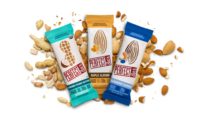With the consistent growth of the snack bar category over the past few years, the Almond Board of California wanted to better understand consumer usage, consumption and perceptions of various types of bars. We did so by taking a look at the overall bar landscape, including consumers’ wants, needs and trends to evaluate their preferences for ingredients, including almonds. We also wanted to identify key opportunities for almonds in the bar category.
In the consumer study, we asked participants what the top ingredients would be in their “ideal” snack bar (“U.S. Bars Exploratory Study,” 2014, Sterling-Rice Group). Almonds were named as the most-desired ingredient nut in consumers’ “ideal bar,” leading the way with 27 percent. Other top ingredients included granola (26 percent), dark chocolate (24 percent) and oats (19 percent).
These findings inspired us to work with a research chef to translate the data into a snack concept, keeping in mind that “chewy” was the most-preferred texture. As a result of being able to incorporate the top ingredients named in the consumer survey, we deemed the final product the “Perfect Snack Bar.”
In addition to incorporating top ingredient choices, the Perfect Snack Bar features four almond forms, further showcasing almonds’ versatility. Each form serves a unique purpose: almond butter to “bind” the ingredients together; whole, roasted almonds for notable crunch; sliced, toasted almonds for nutty flavor; and almond flour to increase the bar’s density and texture. Other ingredients include coconut flakes and honey, which were identified, respectively, as the top fruit flavor and the most-popular sweetener by survey participants. They add to the bar’s appealing taste and consistency.
Among consumers who chose almonds in their “ideal bar,” “taste” (71 percent) was the top reason, followed by “heart health” (56 percent) and “to add protein” (52 percent). Scientific evidence suggests, but does not prove, that eating 1.5 ounces of most nuts, such as almonds, as part of a diet low in saturated fat and cholesterol may reduce the risk of heart disease. One serving of almonds (28 grams) has 13 grams of unsaturated fat and only 1 gram of saturated fat. Also, almonds contain 6 grams of protein per ounce.
When consumers were asked to rate the benefits they look for in snack bars, they chose “great taste,” “high in protein,” “high in fiber” and “filling and satisfying.” In a recent study, researchers found that a mid-morning snack of almonds generates satiety (“A mid-morning snack of almonds generates satiety and appropriate adjustment of subsequent food intake in healthy women,” European Journal of Nutrition, August 2015). Formulating with almonds can help manufacturers meet consumer demands for these attributes.








